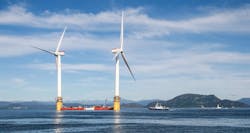Floating Wind JIP report addresses technology challenges
Offshore staff
LONDON – The Carbon Trust has released the latest summary findings from the Floating Wind joint industry project (JIP).
“The Floating Wind Joint Industry Project - Phase II summary report” outlines technology challenges prioritized by developers to accelerate the commercialization of floating wind.
The findings summarize the work across four main themes: turbine requirements and foundations scaling, heavy lift offshore operations, dynamic export cables, and monitoring and inspection.
The report also includes new market projections from the Carbon Trust, forecasting 70 GW of floating wind capacity installed by 2040.
Floating wind is an emerging but growing renewable energy sector. The technology enables offshore wind turbine installation in deeper waters not suitable for bottom-fixed turbines. Pilot and demonstration projects have shown the potential for similar, or even higher yields from floating turbines compared to bottom-fixed projects, as they can be situated in locations with higher wind resource.
However, technology development challenges to commercialization remain. Phase II projects addressed some of these, with key findings below.
Next-generation turbines only need minor modifications for floating. A study on turbine requirements and foundations scaling, delivered by Ramboll, looked at the potential impacts of installing larger, next generation turbines on floating substructures. Aside from turbine towers and controllers, it found that only minor modifications would likely be needed for future turbines, and that the required relative primary steel, secondary steel, and mooring mass decreases for larger turbines.
New vessels or alternative lifting solutions needed for floating offshore heavy lift operations. Seaway 7 investigated the challenges associated with floating heavy lift offshore construction and maintenance operations for turbines up to 20 MW. It found that the limited availability and high cost of suitable floating heavy lift vessels in the market at present is a barrier to cost effectively undertaking operations offshore. There is a need for vessels capable of undertaking the required heavy lift operations or alternative lifting solutions, such as climbing crane technology.
Dynamic export cable products for floating farms in development. This project, delivered by BPP Cable Solutions, investigated the challenges and assisted in the development of high voltage dynamic export cables required to transport power from floating offshore wind farms. Previous JIP studies have highlighted a lack of suitable dynamic cables currently available on the market. A competition was launched to support cable manufacturers develop and test suitable designs. Five cable manufacturers are currently being supported by the JIP to make these available as products for future projects.
No ‘quick win’ solutions for floating monitoring and inspection. Oceaneering looked at the techniques for assessing the integrity of floating wind farms. It concluded that improvement is needed in both the collection of data and its usage to inform and manage asset integrity for floating wind farms, and for subsea assets. For this there were no ‘quick win’ solutions, but techniques such as a digital twin approach, or unmanned vessels, could support cost effective solutions.
Dan Kyle Spearman, manager of the Floating Wind JIP, the Carbon Trust, said: “… it is clear that floating wind offers technology and supply chain investment opportunities.
“We expect that it will become a key sector for low carbon power generation and economic growth in geographies where deeper waters do not allow for bottom-fixed offshore wind turbines. The time is now for the floating wind industry to look to pre-commercial and commercial projects to deliver the cost reduction necessary for the sector to compete with other renewable energy options.”
07/14/2020
